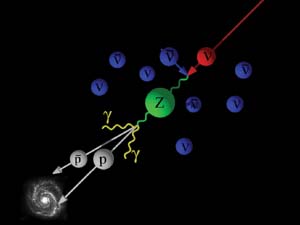
Cosmic-ray particles with the highest energies could give us clues about the mass of the relic particles from the Big Bang with the lowest energies – neutrinos – according to recent research. Big Bang cosmology predicts the existence of a background gas of free photons and neutrinos. The measured cosmic microwave background radiation supports the applicability of standard cosmology back to approximately 100,000 years after the Big Bang. A measurement of the relic neutrinos, which are nearly as abundant as the relic photons, could provide a new window to earlier times when the universe was just 1 s old. Since neutrinos interact only weakly, however, relic neutrinos have not yet been detected directly in laboratory experiments.
A recently proposed possibility for detecting relic neutrinos indirectly is based on so-called Z-bursts resulting from the resonant annihilation of ultrahigh-energy cosmic neutrinos with relic neutrinos into Z bosons, mediators of the weak interaction. On resonance, the corresponding cross-section is enhanced by several orders of magnitude. If neutrinos have non-vanishing masses – for which there is convincing evidence in view of the observation of neutrino oscillations (Direct evidence seen for oscillations) – the respective resonance energies, in the rest system of the relic neutrinos, correspond to around 4 x 1021 eV.
Such resonance energies are, for neutrino masses in the 1 eV range, remarkably close to the energies of the highest-energy cosmic rays observed at Earth by means of air-shower detectors such as the Akeno Giant Air Shower Array (AGASA) in Japan. Indeed, it has been argued recently that ultrahigh-energy cosmic rays above the predicted Greisen-Zatsepin-Kuzmin (GZK) cut-off around 4 ¥ 1019 eV are mainly protons from Z-bursts. This would possibly solve one of the outstanding problems of ultrahigh-energy cosmic-ray physics – the observation of cosmic rays with energies above the GZK cut-off – in an elegant and economical way without invoking new physics beyond the Standard Model, other than neutrino masses.
The GZK puzzle hinges on the fact that nucleons with super-GZK energies have a short attenuation length of about 50 Mpc, due to inelastic interactions with the cosmic microwave background, while plausible astrophysical sources for those energetic particles are much farther away.
Ultrahigh-energy neutrinos produced at cosmological distances, on the other hand, can reach our cosmological neighbourhood unattenuated and their resonant annihilation with relic neutrinos could result in the observed cosmic rays of the highest energies.
The energy spectrum of the highest-energy cosmic rays depends critically on neutrino mass if they are indeed produced via Z-bursts. From a comparison of the predicted spectrum with the observed one, the required mass of the heaviest neutrino can therefore be inferred. It turns out to lie in the range 0.04-0.76 eV, which compares favourably with current experimental indications. The required ultrahigh-energy cosmic neutrinos should be observed in the near future by existing neutrino telescopes, such as AMANDA at the South Pole, and by cosmic-ray air-shower detectors currently under construction, such as the Pierre Auger Observatory. If they are not, the Z-burst hypothesis for the origin of the highest-energy cosmic rays will be ruled out.
Further reading
Z Fodor, S D Katz and A Ringwald (2002) Phys. Rev. Lett. 88 171101.





